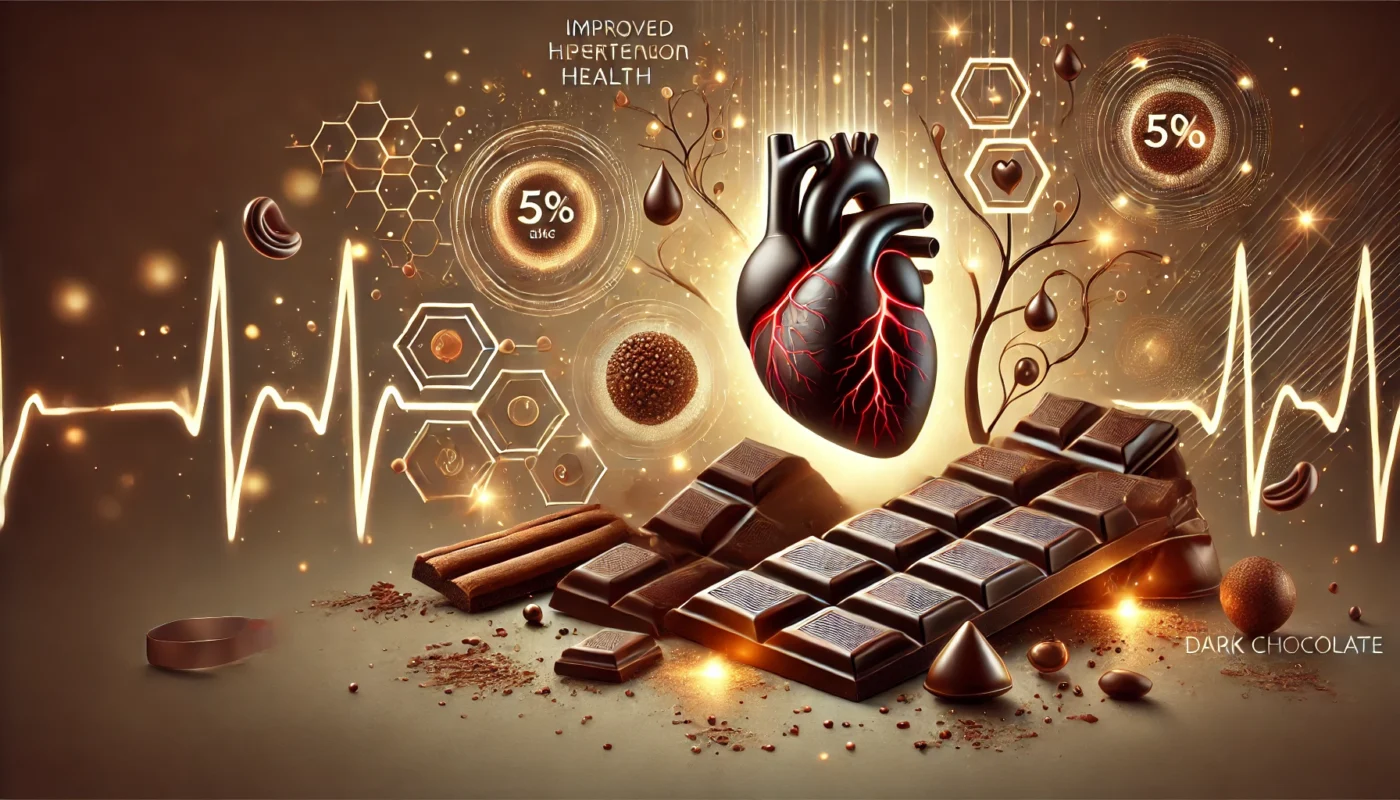Hypertension, or high blood pressure, is one of the most significant public health challenges, affecting nearly half of the adult population worldwide according to the World Health Organization (WHO). It increases the risk of heart disease, stroke, and kidney failure, making effective management critical. While lifestyle modifications like diet, exercise, and stress reduction are well-documented ways to control blood pressure, recent studies have brought a surprising contender into the spotlight: dark chocolate. Known for its rich flavor and indulgent qualities, dark chocolate also boasts potential cardiovascular benefits. This article delves into the science behind dark chocolate and its effects on hypertension, exploring what works, what doesn’t, and how to incorporate this treat wisely into your diet.
You May Also Like:
The Role of Alcohol in Hypertension: Can You Drink Responsibly?
Screen Time and Hypertension: Is There a Connection?
Is Dark Chocolate Good for Hypertension? The Facts Explained is an original (HSLHealing) article.
The Nutritional Composition of Dark Chocolate
Dark chocolate is made from the seeds of the cacao tree, a rich source of bioactive compounds with potential health benefits. Key components include:
1. Flavanols
Flavanols, a type of flavonoid found in cacao, are powerful antioxidants that support vascular health. They enhance nitric oxide (NO) production in the endothelium, the inner lining of blood vessels, leading to improved blood flow and lower blood pressure.
- Concentration: Dark chocolate contains higher levels of flavanols compared to milk chocolate or white chocolate, with higher cacao percentages delivering more potent effects.
2. Minerals
Dark chocolate is a good source of magnesium, potassium, and calcium, minerals essential for maintaining healthy blood pressure.
3. Low Sugar (in High-Quality Dark Chocolate)
Unlike milk chocolate, high-quality dark chocolate has less sugar and fewer unhealthy additives, making it a better choice for cardiovascular health.

The Science Behind Dark Chocolate and Hypertension
Numerous studies have investigated the effects of dark chocolate on blood pressure, providing compelling evidence of its potential benefits.
1. Flavanols and Nitric Oxide Production
Flavanols stimulate the production of nitric oxide, a molecule that relaxes blood vessels, reduces vascular resistance, and lowers blood pressure.
- Evidence: A randomized controlled trial published in The Journal of the American Medical Association (JAMA) in 2007 found that participants who consumed dark chocolate rich in flavanols experienced a significant reduction in systolic blood pressure (SBP) by an average of 3 mmHg and diastolic blood pressure (DBP) by 2 mmHg over two weeks.
2. Reduction in Inflammation
Dark chocolate has anti-inflammatory properties that can reduce arterial stiffness and improve vascular function, both of which are critical for blood pressure control.
- Evidence: A study in Circulation (2014) demonstrated that regular consumption of dark chocolate lowered markers of inflammation, leading to improved cardiovascular outcomes.
3. Improved Insulin Sensitivity
Insulin resistance is a common factor in hypertension. Flavanols in dark chocolate improve insulin sensitivity, helping regulate blood pressure.
- Evidence: A meta-analysis in The American Journal of Clinical Nutrition (2012) found that dark chocolate consumption reduced both blood pressure and fasting insulin levels in individuals with metabolic syndrome.
How Effective Is Dark Chocolate for Hypertension?
While the evidence is promising, the magnitude of blood pressure reduction achieved with dark chocolate is modest compared to other interventions like exercise, the DASH diet, or antihypertensive medications. On average, studies report reductions of 2–5 mmHg in SBP and 1–2 mmHg in DBP.
- Clinical Significance: These reductions, though small, are meaningful at the population level and can complement other lifestyle changes for hypertension management.

The Caveats: What Dark Chocolate Cannot Do
Despite its potential benefits, dark chocolate is not a magic bullet for hypertension. There are limitations to its use:
- Caloric Density
Dark chocolate is calorie-dense, and overconsumption can lead to weight gain, which is a risk factor for hypertension. - Variability in Flavanol Content
The flavanol content of dark chocolate varies widely among brands and products. Some commercially available chocolates contain minimal flavanols due to processing. - High Saturated Fat Content
Although dark chocolate contains heart-healthy fats, it also has saturated fats, which should be consumed in moderation. - Individual Responses
The blood pressure-lowering effects of dark chocolate may vary depending on an individual’s baseline blood pressure, diet, and genetic predisposition.

Choosing the Right Dark Chocolate for Hypertension
Not all dark chocolates are created equal. To maximize health benefits while minimizing potential drawbacks, consider the following factors:
1. Cacao Percentage
Select dark chocolate with at least 70% cacao. Higher cacao content correlates with higher flavanol levels and lower sugar content.
2. Minimal Processing
Opt for minimally processed chocolate, as excessive processing can degrade flavanol content.
3. Low Added Sugar
Check the label for added sugars. High-quality dark chocolate should contain minimal sugar.
4. Avoid Additives
Avoid chocolates with unhealthy additives like hydrogenated oils or artificial flavors.
Incorporating Dark Chocolate into a Heart-Healthy Diet
Dark chocolate should be consumed as part of a balanced diet, not as a replacement for other proven strategies to manage hypertension.
1. Portion Control
Limit intake to 1–2 ounces (30–60 grams) per day to avoid excessive calorie consumption.
- Tip: Break a small piece of dark chocolate into smaller portions to extend enjoyment.
2. Combine with Other Heart-Healthy Foods
Pair dark chocolate with fruits like berries or nuts for a nutrient-rich snack. The antioxidants in berries and healthy fats in nuts complement the cardiovascular benefits of dark chocolate.
3. Use as a Flavor Enhancer
Add grated dark chocolate to oatmeal, yogurt, or smoothies for a subtle boost of flavor and flavanols without overindulging.
Omega-3 fatty acids improve heart health and reduce hypertension—Shop Trusted Supplements on Amazon!

Complementary Lifestyle Strategies for Hypertension Management
Dark chocolate alone is not sufficient for managing hypertension. Incorporate these additional strategies for a holistic approach:
1. Adopt the DASH Diet
The Dietary Approaches to Stop Hypertension (DASH) diet emphasizes fruits, vegetables, whole grains, lean proteins, and low-fat dairy. Dark chocolate can be a small part of this balanced diet.
- Evidence: A study in The New England Journal of Medicine (1997) showed that the DASH diet reduced SBP by 11.4 mmHg in hypertensive individuals.
2. Exercise Regularly
Engage in at least 150 minutes of moderate-intensity aerobic activity weekly, such as brisk walking or cycling, to strengthen the heart and lower blood pressure.
3. Manage Stress
Stress contributes to hypertension through elevated cortisol levels. Practices like mindfulness, yoga, and meditation can help reduce stress-induced blood pressure spikes.
4. Monitor Sodium Intake
Limit sodium to less than 2,300 mg per day, as excessive sodium increases blood pressure.
CoQ10 enhances cardiovascular health and stabilizes blood pressure—Order Yours Today on Amazon!

Nutritional Supplements for Hypertension
In addition to dark chocolate and lifestyle changes, certain supplements can further support blood pressure control:
1. Hibiscus Extract
Hibiscus promotes nitric oxide production and reduces vascular stiffness. The Journal of Nutrition (2010) reported a 6 mmHg reduction in SBP with daily hibiscus tea consumption.
2. Omega-3 Fatty Acids
Omega-3s reduce inflammation and improve arterial flexibility. A meta-analysis in Hypertension (2018) showed a 4 mmHg reduction in SBP with omega-3 supplementation.
3. Beetroot Powder
Beetroot powder enhances nitric oxide levels and improves blood flow. A study in Nutrition Journal (2017) found a 4 mmHg reduction in SBP after regular use.
4. Magnesium Glycinate
Magnesium helps relax blood vessels and supports cardiovascular health. A study in Magnesium Research (2016) reported a 5 mmHg reduction in SBP with magnesium supplementation.
5. Coenzyme Q10 (CoQ10)
CoQ10 reduces oxidative stress and improves endothelial function. A clinical trial in Hypertension Research (2007) found that CoQ10 supplementation lowered SBP by 11 mmHg.
Conclusion
Dark chocolate, particularly varieties rich in flavanols, offers a delicious and scientifically supported way to complement hypertension management. By promoting nitric oxide production, reducing inflammation, and improving insulin sensitivity, dark chocolate can contribute to modest reductions in blood pressure. However, it should be consumed in moderation and incorporated into a broader strategy that includes a heart-healthy diet, regular exercise, and stress management. While dark chocolate is not a cure for hypertension, it is a flavorful addition to a comprehensive approach to improving cardiovascular health.

References
- The Journal of the American Medical Association. (2007). Effects of dark chocolate on blood pressure. JAMA. Retrieved from https://jamanetwork.com
- Circulation. (2014). Anti-inflammatory effects of flavanols in dark chocolate. Circulation. Retrieved from https://www.ahajournals.org
- The American Journal of Clinical Nutrition. (2012). Flavanol-rich dark chocolate and metabolic syndrome. The American Journal of Clinical Nutrition. Retrieved from https://academic.oup.com
- The New England Journal of Medicine. (1997). Dietary Approaches to Stop Hypertension. The New England Journal of Medicine. Retrieved from https://www.nejm.org
- Nutrition Journal. (2017). Nitrate-rich beetroot supplementation and vascular health. Nutrition Journal. Retrieved from https://www.biomedcentral.com
Important Note: The information contained in this article is for general informational purposes only, and should not be construed as health or medical advice, nor is it intended to diagnose, prevent, treat, or cure any disease or health condition. Before embarking on any diet, fitness regimen, or program of nutritional supplementation, it is advisable to consult your healthcare professional in order to determine its safety and probable efficacy in terms of your individual state of health.
Regarding Nutritional Supplements Or Other Non-Prescription Health Products: If any nutritional supplements or other non-prescription health products are mentioned in the foregoing article, any claims or statements made about them have not been evaluated by the U.S. Food and Drug Administration, and such nutritional supplements or other health products are not intended to diagnose, treat, cure, or prevent any disease.

